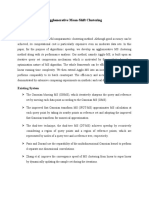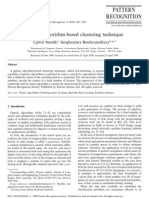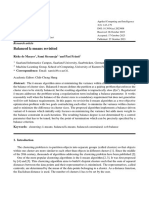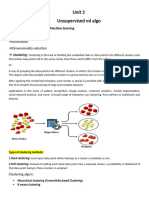K-Means and K-Modes Algorithms To Allow For Clustering Objects Described by Mix The K
Uploaded by
Prem KumarK-Means and K-Modes Algorithms To Allow For Clustering Objects Described by Mix The K
Uploaded by
Prem KumarThe k-means algorithm is well known for its efficiency in clustering large data sets.
However, working only on numeric values prohibits it from being used to cluster real world data containing categorical values. In this paper we present two algorithms which extend the kmeans to minimise the clustering cost function. With these extensions the k-modes algorithm enables the clustering of categorical data in a fashion similar to k-means. The k-prototypes algorithm, through the definition of a combined dissimilarity measure, further integrates the k-means and k-modes algorithms to allow for clustering objects described by mix The kmodes algorithm uses a simple matching dissimilarity measure to deal with categorical objects, replaces the means of clusters with modes, and uses a frequency-based method to update modes in the clustering process to minimise the clustering cost function. With these extensions the k-modes algorithm enables the clustering of categorical data in a fashion similar to k-means. The k- objects described by mix The k-modes algorithm uses a simple matching dissimilarity measure to deal with categorical objects, replaces the means of clusters with modes, and uses a frequency-based method to update modes in the clustering process to minimise the clustering cost function. With these extensions the k-modes algorithm enables the clustering of categorical data in a fashion similar to k-means. The kprototypes ed numeric and iments on two real world data sets with half a million objects each show that the two algorithms are efficient when clustering large data sets, which is critical to data mining applications.
You might also like
- K-Means and K-Modes Algorithms To Allow For Clustering Objects Described by Mix The KNo ratings yetK-Means and K-Modes Algorithms To Allow For Clustering Objects Described by Mix The K1 page
- Approval Data Sets To Demonstrate The Clustering Performance of The Two Algorithms. OurNo ratings yetApproval Data Sets To Demonstrate The Clustering Performance of The Two Algorithms. Our1 page
- Clustering Algorithms On Data Mining in Categorical DatabaseNo ratings yetClustering Algorithms On Data Mining in Categorical Database4 pages
- A Novel Approach of Implementing An Optimal K-Means Plus Plus Algorithm For Scalar DataNo ratings yetA Novel Approach of Implementing An Optimal K-Means Plus Plus Algorithm For Scalar Data6 pages
- A Fast Clustering Algorithm To Cluster Very Large Categorical Data Sets in Data MiningNo ratings yetA Fast Clustering Algorithm To Cluster Very Large Categorical Data Sets in Data Mining8 pages
- Parallel MS-Kmeans Clustering Algorithm Based On MNo ratings yetParallel MS-Kmeans Clustering Algorithm Based On M18 pages
- The Application of K-Medoids and PAM To The Clustering of RulesNo ratings yetThe Application of K-Medoids and PAM To The Clustering of Rules6 pages
- Clustering Algorithms For Mixed Datasets: A Review: K. Balaji and K. LavanyaNo ratings yetClustering Algorithms For Mixed Datasets: A Review: K. Balaji and K. Lavanya10 pages
- Efficient Data Clustering With Link ApproachNo ratings yetEfficient Data Clustering With Link Approach8 pages
- A Two Step Clustering Method For Mixed Categorical and Numerical DataNo ratings yetA Two Step Clustering Method For Mixed Categorical and Numerical Data9 pages
- Genetic Algorithm-Based Clustering TechniqueNo ratings yetGenetic Algorithm-Based Clustering Technique11 pages
- Clustering Techniques and Their Applications in Engineering100% (1)Clustering Techniques and Their Applications in Engineering16 pages
- Arraycluster: An Analytic Tool For Clustering, Data Visualization and Module Finder On Gene Expression ProfilesNo ratings yetArraycluster: An Analytic Tool For Clustering, Data Visualization and Module Finder On Gene Expression Profiles26 pages
- Analysis&Comparisonof Efficient TechniquesofNo ratings yetAnalysis&Comparisonof Efficient Techniquesof5 pages
- Dynamic Approach To K-Means Clustering Algorithm-2No ratings yetDynamic Approach To K-Means Clustering Algorithm-216 pages
- A Fast K-Means Implementation Using CoresetsNo ratings yetA Fast K-Means Implementation Using Coresets10 pages
- Customer Categorization by Data Analysis Using Clustering Algorithms of Machine LearningNo ratings yetCustomer Categorization by Data Analysis Using Clustering Algorithms of Machine Learning4 pages
- A Relational Graph Based Approach Using Multi-Attribute Closure Measure For Categorical Data ClusteringNo ratings yetA Relational Graph Based Approach Using Multi-Attribute Closure Measure For Categorical Data Clustering5 pages
- Journal of Computer Applications - WWW - Jcaksrce.org - Volume 4 Issue 2No ratings yetJournal of Computer Applications - WWW - Jcaksrce.org - Volume 4 Issue 25 pages
- Student Project Online K-Means ClusteringNo ratings yetStudent Project Online K-Means Clustering11 pages
- Efficient Solution Algorithms For Factored MdpsNo ratings yetEfficient Solution Algorithms For Factored Mdps70 pages
- A Method For Comparing Content Based Image Retrieval MethodsNo ratings yetA Method For Comparing Content Based Image Retrieval Methods8 pages
- JNTUK R20 B.Tech CSE 3-2 Machine Learning Unit 4 NotesNo ratings yetJNTUK R20 B.Tech CSE 3-2 Machine Learning Unit 4 Notes23 pages
- A K-Means Based Genetic Algorithm For Data Clustering: Advances in Intelligent Systems and Computing October 2017No ratings yetA K-Means Based Genetic Algorithm For Data Clustering: Advances in Intelligent Systems and Computing October 201712 pages
- SQLDM - Implementing K-Means Clustering Using SQL: Jay B.SimhaNo ratings yetSQLDM - Implementing K-Means Clustering Using SQL: Jay B.Simha5 pages
- Expert Systems With Applications: Jing Xiao, Yuping Yan, Jun Zhang, Yong TangNo ratings yetExpert Systems With Applications: Jing Xiao, Yuping Yan, Jun Zhang, Yong Tang8 pages
- Ijert Ijert: Enhanced Clustering Algorithm For Classification of DatasetsNo ratings yetIjert Ijert: Enhanced Clustering Algorithm For Classification of Datasets8 pages
- Improving Analysis of Data Mining by Creating Dataset Using SQL AggregationsNo ratings yetImproving Analysis of Data Mining by Creating Dataset Using SQL Aggregations6 pages
- Genetic K-Means Algorithm: Conf., 1987, Pp. 50-58No ratings yetGenetic K-Means Algorithm: Conf., 1987, Pp. 50-587 pages
- C: A Hierarchical Clustering Algorithm Using Dynamic ModelingNo ratings yetC: A Hierarchical Clustering Algorithm Using Dynamic Modeling22 pages
- 1) A Link Based Cluster Enemble Approach For Categorical Data ClustingNo ratings yet1) A Link Based Cluster Enemble Approach For Categorical Data Clusting6 pages
- A Hybrid Algorithm Based On KFCM-HACO-FAPSO For Clustering ECG BeatNo ratings yetA Hybrid Algorithm Based On KFCM-HACO-FAPSO For Clustering ECG Beat6 pages
- Clustering Large Data Sets With Mixed Numeric and Categorical ValuesNo ratings yetClustering Large Data Sets With Mixed Numeric and Categorical Values14 pages
- Clustering Categorical Data Using The K Means Algorithm and The Attributes Relative FrequencyNo ratings yetClustering Categorical Data Using The K Means Algorithm and The Attributes Relative Frequency7 pages
- DATA MINING and MACHINE LEARNING: CLUSTER ANALYSIS and kNN CLASSIFIERS. Examples with MATLABFrom EverandDATA MINING and MACHINE LEARNING: CLUSTER ANALYSIS and kNN CLASSIFIERS. Examples with MATLABNo ratings yet



























































